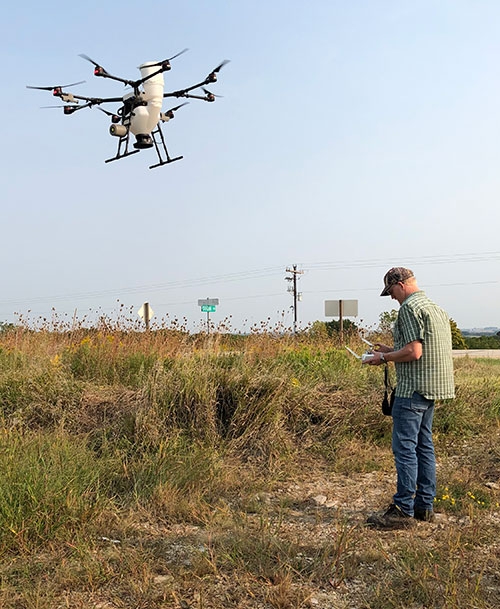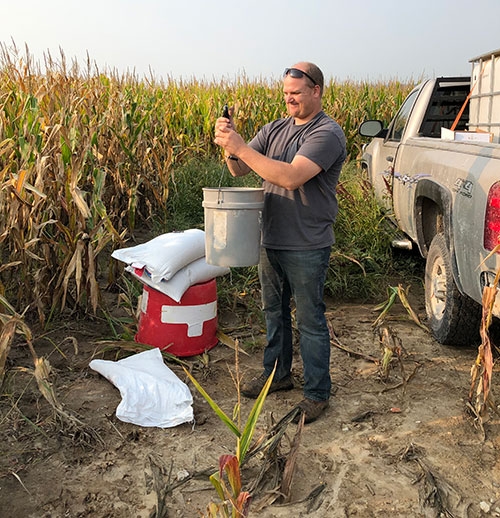You are here
Home ›Using a drone to plant cover crops

Airborne advantages ... Devin Brincks, a Rantizo contractor, is piloting his drone to seed red clover cover crop on the Jon Kruse farm. Submitted photo.

Measuring the cover crop seed ... Jon Kruse of Harpers Ferry measures seed to fill the drone for his seeding. Submitted photo.
by Eric Novey, Allamakee SWCD Project Coordinator
Harpers Ferry farmer Jon Kruse is utilizing a unique method of planting cover crops this fall - a drone. September 16, Kruse hired Devin Brincks, a Rantizo contractor, to fly his drone over standing soybeans to seed red clover as a cover crop.
Aerial cover crop application is growing in popularity across Iowa because of the upsides. A big advantage of aerial seeding is that more acres can be seeded in less time than with ground equipment. Aerial application also allows seeding to be done when it is physically impossible to use ground equipment such as when crops are present or the soil is too wet for regular equipment.
Kruse seeded 10 lbs. of red clover per acre. The drone can carry 25 lbs. of seed and was able to seed two acres in approximately four minutes. Prior to seeding, Brincks logged the perimeter of the field into the drone so when he started seeding the drone utilized GPS technology to start and stop at field edges. He seeded the cover crop at a 20-foot wide swath and maintained a constant height above the crop.
Brincks explained that once he has a field boundary in the drone it can be used year after year. He added that GPS information from a producers’ system can be entered into the drone and used.
Brincks says the battery-operated drone lasts about 20 minutes before needing to be recharged. He carries several batteries and he uses a generator in his pick-up so he can recharge in the field.
Kruse hopes to utilize the red clover cover crop in multiple ways: Initially, for erosion control, but also to fix nitrogen for next year’s corn crop and to control weeds.
He intends to let the red clover grow for as long as possible in the spring and is anticipating only one spray pass for cover crop termination and weed control. He hasn’t determined yet how much nitrogen credit to give for the clover but is considering up to 50 lbs. He is also considering banding ahead of the corn rows and leaving the red clover in the inter-row for erosion and weed control.
Kruse’s clover trial is on approximately 9.5 acres of soybeans. The cost for the drone application was approximately $17 per acre. Brincks says he would like to fly a minimum of 20 acres and has a minimum two-hour trip charge.
The Allamakee Soil & Water Conservation District (SWCD) is considering using a drone for another cover crop application of frost seeding. A drone would allow for seeding when field conditions are not suited to run a tractor. One option would be a frost seeding of brassica mustard in March at four lbs./acre. Brassica mustard grows fast and should provide good ground cover at planting, particularly if planting is postponed to later in the spring. Mustard is a natural bio-fumigant and can help control soybean cyst nematode.
Another option for drone seeding is camelina, a winter hardy broadleaf, seeded at four to six lbs./acre after corn harvest. Brincks said he could also seed mixes as long as they are pre-mixed or if someone is onsite to do the mixing. A possible cover crop mix to fly on would be turnips at one lb./acre and rye grass at seven to eight lbs./acre.
This mix could be flown on when corn is at the V4-V6 stage.

